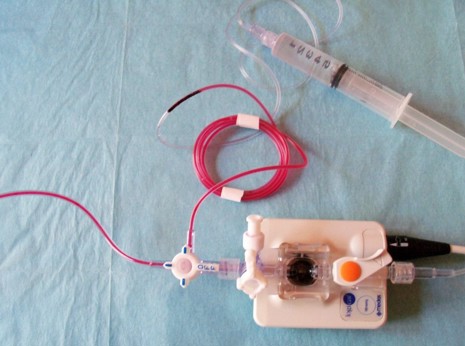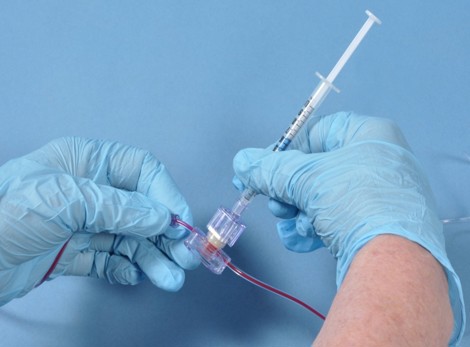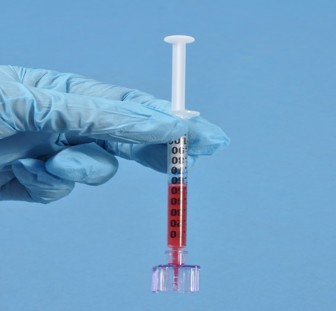Sampling from arterial peripheral / umbilical lines : neonatal guideline
exp date isn't null, but text field is
Objectives
This guideline describes the technique for taking blood samples from an arterial line using the Kids Kit™ Closed Blood Sampling System from Medex.
This Guideline is applicable to all Medical and nursing staff working in neonatal units, which use the Kids Kit™, and who have undertaken the appropriate training for this procedure.
An indwelling arterial line may be used when:
- There is a requirement for frequent arterial blood gas monitoring
- Continuous monitoring of arterial blood pressure is required.
The WoS Neonatal MCN recommends the use of a closed circuit system to reduce the risk of infection secondary to repeated sampling from indwelling arterial lines.
If, when following this procedure, there is any difficulty experienced in obtaining a blood sample from an arterial line, a senior nurse or doctor should be informed immediately
Procedure
-
Check blood sample request form
-
Check request form against baby’s name band
-
Wash and dry hands / use alcohol gel
-
Assemble disposable equipment
- Disposable tray
- Appropriate sample containers (see medical guidelines for required amounts of blood for investigations)
- Sterile gloves
- Sterile towel
- Clinell wipe
- Appropriate syringes (1ml / 2.5ml) / capillary gas tube
- Medex Needle free access device
-
Ensure the infant is comfortable and at rest prior to the procedure.
-
Wash and dry hands / use alcohol gel, don sterile gloves.
-
Place a sterile towel under sample port
-
Silence blood pressure monitoring alarm.
-
Turn 10ml flush syringe (containing heparin 1unit/1ml in Sodium Chloride 0.45%) open to baby and off to transducer and infusion pump as demonstrated. Aspirate blood from arterial line to black marker on the patient line. (as shown)

-
Turn the sampling line 3-way tap to a 45 degree angle so that it is off to both hepsal syringes.

-
Clean the sampling port with the Clinell wipe and allow to dry. Attach the needle free access device to sample syringe.

-
Connect both onto the sampling port, locking into the grooves on both the access device and sampling port. This requires a firm push to open the seal and will only fit one way.
-
Collect sample. To reduce amounts of blood obtained from preterm or low birth weight infants it is common practice to decant the required sample of blood for gas analysis into a capillary gas tube. N.B. Practice at RHSC is to use a heparinised 1ml syringe for blood gas analysis. Other blood samples required at the same time should be obtained with another syringe and needle free adapter.


-
Once sample is obtained remove both syringe and access device as shown.
Never leave needle free adapter on the sample port due to risk of blood loss.
-
Turn the sampling 3-way tap back off to transducer and flush patient line until clear. This is usually the same volume you aspirated (about 1.5 – 2ml) and the amount left in the 10ml syringe is roughly the same – approximately 6 -6.5ml. It is not uncommon to observe intermittent blanching at a peripheral arterial cannula site during flushing, this can be minimised by flushing the line slowly. When the flush is complete, check for any prolonged blanching, discolouration or swelling around the catheter site and in the fingers or toes distal to the catheter. Any abnormality should be reported to the medical staff
-
Turn the sampling tap off to 10ml syringe and open to transducer and heparin infusion. Ensure infusion pump is on and running. Check arterial pressure tracing has returned.
- Some staining of the sampling line with blood is to be expected and the use of excessive amounts of heparinised saline to clear the line should be avoided.
- Fill appropriate blood containers, complete request form and send sample to appropriate department. Record the procedure in nursing notes. Dispose of clinical waste as per hospital policies.
The arterial line and blood sampling system must be visible if possible during and after the procedure to avoid the risk of disconnection and subsequent blood loss (exception is those infants with a UAC nursed prone, where direct assessment of the catheter site is not possible). Arterial lines should be clearly labelled.
Umbilical catheters should be clearly labelled ARTERIAL OR VENOUS and infants with an UAC should be observed for blanching of lower limbs or toes during blood sampling. The arterial line may require re-zeroed if transducer has been disconnected or position altered.
Should the attached 10ml syringe require re-filling, follow instructions as per “Filling a Syringe via Asena Syringe Pump Procedure”.
Last reviewed: 09 October 2023
Next review: 10 September 2026
Author(s): L Raeside – Advanced Neonatal Nurse Practitioner, RHC, Glasgow
Co-Author(s): Original authors: E. Wynne – Practice Development Midwife, NICU, PRMH; A. Kelly – Neonatal Nurse Educator, NICU, RHSC
Approved By: West of Scotland Neonatology Managed Clinical Network

